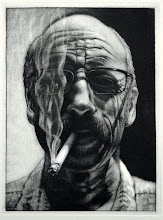
During our discussion in Drawing class the other evening, there were three or four images that included text with the images. Most, if not all, were MKL Jr. quotes: "I have a dream." "In the end we will not remember the violence of our enemies but the silence of our friends."...and so on. These quotes felt a bit like add-ons to the images rather than being an actual part of the image integrated into the structure of the image. There are many artists who use text in their imagery that may be worth looking into, such as Jenny Holzer, Barbara Kruger (see above image), Robert Rauschenberg, Jasper Johns. Below is a site that looks at a lot of different artists who combine text and imagery. Check it out.

In looking at some of the artists shown here, it seems to me that the word are their art vs trying to pull text into a drawing and make it better. I've always had problems with trying to do that, I've never felt that anything I've done improves my image.
ReplyDeleteI think the biggest hurdle to overcome with text in images is the actual typography. How well can you render the text. Most handwriting just looks like an afterthought as Brian stated. I think text can work, but it needs all the same attention and craftsmanship as the rest of the composition. Simple things like choosing a font that enhances the piece are important. You could look at any comic book or advertisement or movie poster to find inspiration.
ReplyDeleteI don't think it is just an issue of typography, though I do agree the font needs just as much attention to become a real part of the composition. I think another part of the problem stems from the conflict between word and image. I tend to find text in an image distracting because my focus becomes reading what it says and I pay little attention to the image itself. However, I like the example above because the text is the foreground, it doesn't distract because it is the subject and image is more of a backdrop.
ReplyDeleteAs a graphic design major i definitely believe typography is extremely important when using text within an image. if your text is slanting down hill or not sized properly it is very distracting and will always look like an after thought like we have all stated. But i also agree that if the text is within the background of and image it really has no purpose being there...i mean whats the point of writing something out if its the secondary piece of the work? I understand that the writing could pretain to the theme of the piece but i honestly believe text isnt the star within the drawing world. Now it would be acceptable to use within the foreground of a piece with an image in the background. I believe that would be the best choice for text. But in my opinion text and drawing dont mix.
ReplyDeleteAlthough the piece at the beginning of this post clearly pays graphic attention to "font", in images created through more traditional media, such as charcoal, graphite, pastels, and paints, typography is not an equal issue. In fact, I would bet that the words "typography" or "font" are hardly considered in that vernacular. Artists have used text/words for decades, even centuries. However, the manner of use has evolved considerable. Sometimes the text is legible and sometimes not. Sometimes it's function is to inform, and sometimes not. Sometimes it's used to incite, decorate, provide context, or sometimes just TEXTure. Lois Main Templeton, an artist from indianapolis said in an interview about when she "writes" on her paintings: "I was especially interested in the line. When I started taking classes, I didn't think I could draw; I still don't think I can. But when one of my instructors said 'you have to choose between painting and drawing becasue you can't have both,' I said, 'yes, I can.' For me, writing words on my paintings is an extension of my interest in the line. If you're usng calligraphy, you're using line. But I'm also a wordy person. We all have words coming to us all the time. I just make some of mine visual." Her work is very interesting in her use of text; you can see her work at:
ReplyDeletewww.loistempleton.com
i like this piece it seems to have alot of meaning to it...
ReplyDeleteI really like lois' stuff she has a really interesting way of incorporating the text into her art. I really enjoy using text in my art the biggest problem for me is trying to not get the billboard effect where the text makes the piece seem more like an ad. It is nice to see work that incorporates text in an interesting and effective way.
ReplyDeletecombining text in art seems to be very tricky especially if the final piece is a traditional drawing. it is so easy to distort the x-height or the kerning between letters and make the image read incorrectly. If the text is in perspective, well that is an entirely different monster to tackle. Does anyone have any tips for working with type in a drawing?
ReplyDelete